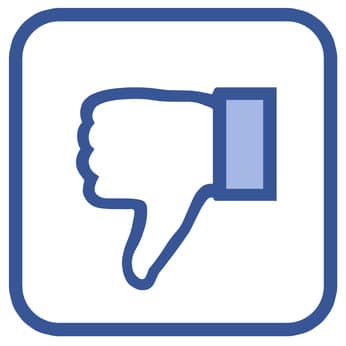Social media is a gathering place for people to share their thoughts and opinions, ask for feedback, keep track of out of state relatives, poll friends on the best Mexican food in town, and the list goes on. If you’re a brand using social media, these activities probably differ somewhat. Whether it’s important to your company to build a large, credible community, share thought-leadership content, promote events, or just to get everyone talking, it’s important to remember the “rules” to not alienating your community. There are a few things every would-be community manager should keep in mind before posting, tweeting, sharing, and liking as their brand. Read on for an overview of some of the most frequent offenses we see on Facebook and Twitter day to day.
Let’s start with Facebook, which just might be the best platform to showcase brand blunders and Oops! moments due to its layout.
Do NOT like your own Facebook content.
Honestly, this just looks silly and self-serving. If your brand posted the update, it’s pretty obvious you “like” it or endorse it. Nothing makes us cringe more than when we see a brand like its own Facebook update – whether the update was about a groundbreaking new product, a fabulous award, or a photo, try to restrain yourself from hitting that “Like” button after it’s posted. However, it is completely acceptable to like a comment that someone makes on your update. Just somethin’ to keep in mind 😉
Do NOT refer customers to a generic help line, whenever possible.
Did someone post on your brand’s Facebook wall asking a product question? Maybe they sent a private message asking where they can find a particular product overseas? It may be easy to refer them to a general customer service phone number, but it’s definitely better to find the answer for them. Don’t know the answer yourself? Reach out to someone who can answer it for you. Ask your client to refer you to a salesperson or expert to answer a technical question, or better yet, call the customer service department yourself and deliver the goods to your inquiring Facebook buddy. Going a step above the usual will make you stand apart, and your customers will thank you for it.
Do NOT bombard everyone’s News Feed with your updates.
We have all seen that person who updates their Facebook status 16 times a day, sharing every detail of their lives. If you’re a brand, it’s important to be mindful of how many times you’re posting per day. Granted, not all of your followers are seeing your posts, but the ones who are may just decide to Unlike your page if you’re updates are too intrusive into their personal Facebook experience. Remember, people are usually on Facebook for social reasons, so an inundation of corporate media into free time is a major turn-off. Though there is no exact formula, posting to Facebook two to three times per day is perfectly acceptable. Make sure you space your updates out as much as possible to avoid turning your fans into former fans.
Next up, let’s talk about good ol’ Twitter. Twitter is a horse of a different color compared to Facebook, and it comes with its own set of really cringe-worthy faux pas.
#Do #NOT #Hashtag #Every #Darn #Word.
We get it. Twitter made the hashtag a thing, but it’s obnoxious to #hashtag #everything. This annoyance kind of speaks for itself. If people are annoyed by a brand’s incessant hashtag use, that’s not a good thing. Hashtag wisely and when it makes sense to. Use your best judgment.
Do NOT forget to give credit where credit is due.
That scrumptious brownie-chocolate chip cookie recipe you found online to share with a bakery’s Twitter following sounds delicious, doesn’t it? Share your thanks for the find and help build engagement by @mentioning Website XYZ for the recipe you found on their site when you share it with the bakery’s following! It will make you look like you did your research, and it will help build good will with a resource.
Do NOT take your dear, sweet time responding.
Twitter, more than any other social channel, demands instantaneous response. Well, maybe not instantaneous, but really, really quick. If you’re a brand on Twitter, you might want to consider having your CM install an app like TweakDeck or Twicca on their phones so they can respond as quickly as possible. People on Twitter expect quick answers; that’s why they tweeted at you. Because so many people use Twitter almost exclusively on their phones, think of the timing you should respond to a tweet as comparable to that of texting…only on Twitter.
While these certainly aren’t all of the social media grievances we encounter, it’s a good start. A good thing to ask yourself is this: Would I find this post/tweet/update obnoxious or annoying if it were in my own personal feed? Each of these points of advice can be applied across the social channels. Now tell us, what are YOUR biggest pet peeves when it comes to brand social media etiquette?











